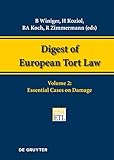Digest of European Tort Law. Volume 2, Essential Cases on Damage / ed. by Helmut Koziol, Benedict Winiger, Bernhard A. Koch, Reinhard Zimmermann.
Material type: TextSeries: Digest of European Tort Law ; Volume 2Publisher: Berlin ; Boston : De Gruyter, [2011]Copyright date: ©2012Description: 1 online resource (1176 p.)Content type:
TextSeries: Digest of European Tort Law ; Volume 2Publisher: Berlin ; Boston : De Gruyter, [2011]Copyright date: ©2012Description: 1 online resource (1176 p.)Content type: - 9783110248487
- 9783110248494
- 340
- KJC1610 .A52 2011
- online - DeGruyter
| Item type | Current library | Call number | URL | Status | Notes | Barcode | |
|---|---|---|---|---|---|---|---|
 eBook
eBook
|
Biblioteca "Angelicum" Pont. Univ. S.Tommaso d'Aquino Nuvola online | online - DeGruyter (Browse shelf(Opens below)) | Online access | Not for loan (Accesso limitato) | Accesso per gli utenti autorizzati / Access for authorized users | (dgr)9783110248494 |
Frontmatter -- Preface -- Overview -- Table of Contents -- Abbreviations -- Questionnaire Structure -- Questionnaire -- 1. General Overview -- 2. Objective Value -- 3. Subjective Value -- 4. Loss of Working Capacity -- 5. Primary and Consequential Damage -- 6. Positive Damage and Loss of Profit -- 7. Loss of Illicit Profits -- 8. Damage without any Material Alteration -- 9. Reliance and Expectation Loss -- 10. Alteration of a Good or Diminution of its Value -- 11. Non-Pecuniary Damage in General -- 12. Non-Pecuniary Consequential Damage -- 13. Non-Pecuniary Damage without Harm -- 14. Value of Affection -- 15. Loss of Enjoyment -- 16. Frustration -- 17. Loss of Use -- 18. ‘Grey Area’ between Pecuniary and Non-Pecuniary Damage -- 19. Additional Categories Apart from Pecuniary and Non-Pecuniary Loss -- 20. Wrongful Conception -- 21. Wrongful Birth -- 22. Wrongful Life -- 23. Environmental Damage -- 24. Collective Damage -- 25. Mere Exposure to a Danger -- 26. Loss of a Chance as Damage -- 27. Further Categories -- 28. Others -- Contributors -- Index -- Publications -- Overview. Reports
restricted access online access with authorization star
http://purl.org/coar/access_right/c_16ec
The increasing Europeanisation of the law of delict/torts has produced textbooks, casebooks, monographs, and also sets of model rules of a genuinely European character. A major gap still existing today relates to the experiences gathered in the national legal systems over the past decades. The present work attempts to fill this gap for one key element of tort law: the notion of damage. It thus does what the previous volume in the ‘Digest of European Tort Law’ series did for another key element, ie natural causation. Once again, the publication contains a selection of the most important cases decided in26 states across Europe as well as by the European Court of Justice. For each case the facts and the relevant court decision are presented, and the decision is analysed within the wider context of the development of the respective legal system. In addition, the editors provide comparative analyses of the case law reported in this volume concerning all the specific problems raised under the heading of damage. The publication also looks into how key cases would be resolved under the European model rules drafted in the field of tort law; and it also highlights cases from earlier periods of legal history.The editors believe that the material gathered here may provide guidance for an organic convergence of the national legal systems in Europe. It constitutes the basis of an acquis commun that is infinitely richer (though also much more complex) than the rather bland and abstract concepts contained in national codifications, European legislation, and the modern model rules.
Mode of access: Internet via World Wide Web.
In English.
Description based on online resource; title from PDF title page (publisher's Web site, viewed 29. Nov 2021)


